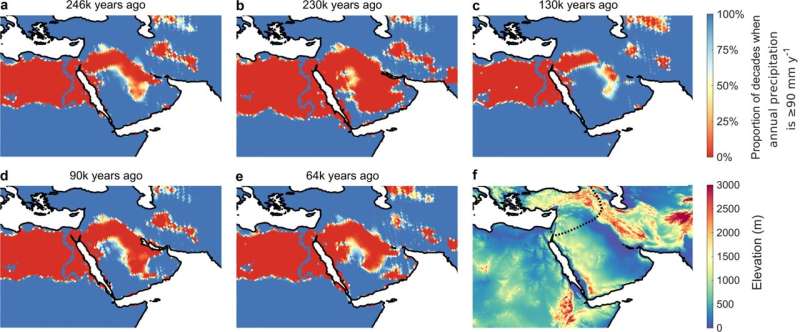August 25, 2021 report
Mapping possible routes for early humans out of Africa using climate models

Bob Yirka
news contributor

A trio of researchers from the University of Cambridge working with a colleague from the University of Tartu has found possible evidence of multiple opportunities for early humans to migrate out of Africa to the Arabian Peninsula prior to the mass migration that occurred approximately 65,000 years ago. In their paper published in the journal Nature Communications, the group describes mapping climate models that show conditions hundreds of thousands of years ago onto possible migration routes of early humans.
Most of the evidence to date suggests that early humans migrated out of Africa to the Arabian Peninsula and on to Eurasia approximately 65,000 years ago. But a question that dogs researchers is, why then? Most in the field have assumed it was a combination of human maturation and opportunity, that the path to Arabia became more conducive to human existence. In looking at a map of northern Africa, migrating to the Arabian Peninsula would appear to be a daunting task. The only land route is across the huge desert covering the Sinai Peninsula. Another option involves crossing what is now the Strait of Bab-el-Mandeb into what is now Yemen.
Logic suggests that a period of increased rainfall on the Sinai would have allowed humans to subsist on animals that fed on the grasses that would have begun to grow there. But such conditions, the researchers argue, likely would have occurred many times throughout human history. To find out if that was the case, they first made one assumption: For early hunter gatherers to survive, they would need to be in a place that had at least 90 millimeters of rainfall per year. Using that figure as a guide, the researchers looked at climate models created by prior researchers that show likely rainfall amounts in the areas where humans were most likely to use paths for migration. They found that conditions were suitable for such migrations multiple times over the past 300,000 years along both the north and easterly routes. Notably, the longest window of opportunity occurred from roughly 30,000 to 65,000 years ago—the same time period that scientists believe the so-called mass migration event occurred.
The researchers note that their findings suggest that it was possible that some early humans migrated to the Arabian Peninsula, and perhaps farther, prior to the mass migration—but their work still does not explain why they were not able to survive there until the mass migrations began.
Written for you by our author —this article is the result of careful human work. We rely on readers like you to keep independent science journalism alive. If this reporting matters to you, please consider a (especially monthly). You'll get an ad-free account as a thank-you.
More information: Robert M. Beyer et al, Climatic windows for human migration out of Africa in the past 300,000 years, Nature Communications (2021).
Journal information: Nature Communications
© 2021 Science X Network





















